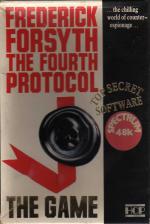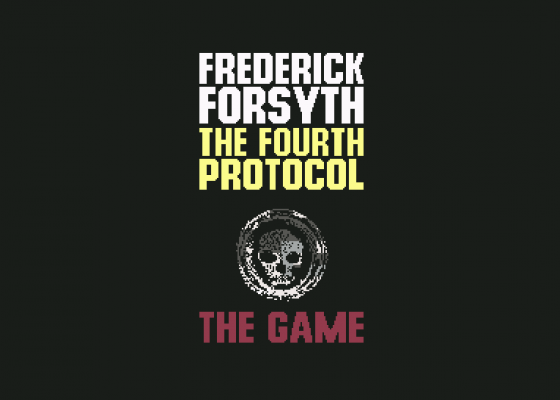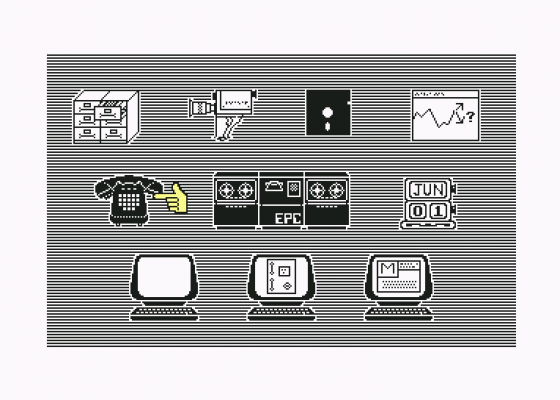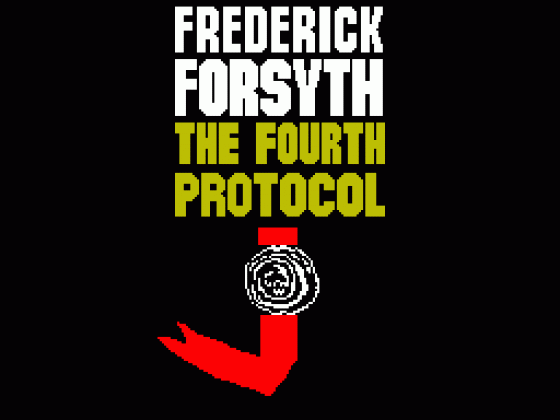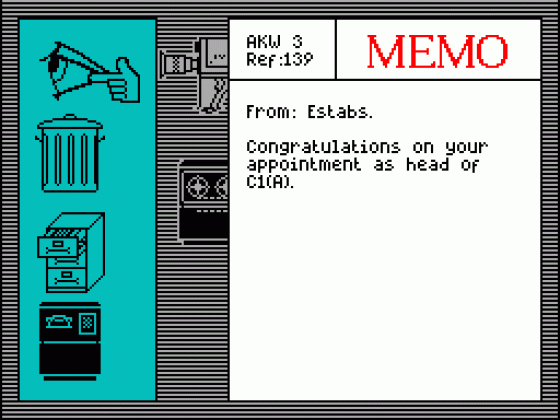
Computer Gamer
 1st June 1985
1st June 1985
Categories: Review: Software
Author: Gordon Hamlett
Publisher: Hutchinson
Machine: Spectrum 48K
Published in Computer Gamer #3
With only days to foil a Russian plot to explode a nuclear bomb in Britain, Gordon Hamlett is seconded to MI5 to investigate.
The Fourth Protocol
Imagine the outrage if a small nuclear device exploded in Britain. As MI5 agent John Preston, rumours have reached your desk that someone is planning to do just that and you have only a limited amount of time to find out exactly who is going to do it, how and where.
Frederick Forsyth's latest thriller is the basis for this game from Hutchinson. The Fourth Protocol is a secret agreement signed by America, Russia and Britain back in 1968. Briefly, it states that none of the signatories can introduce a nuclear device into the territory of another signing natin So far, no-one has tried - until now.
The date is 1987, a few weeks before the general election. Experts in Moscow have decided that if the Labour Party is returned to power, they can control the Government to such an extent that, over the next few years, Britain will withdraw from Nato, allow a Russian invasion and so pave the way for a Soviet takeover of mainland Europe. The problem is to guarantee the election of Labour. Thus plan Aurora is hatched. The idea is to explode a small nuclear bomb and use their disinformation services to blame it on the Americans. This should ensure that enough people switch their allegiance to the only party committed to Unilateral Disarmament.
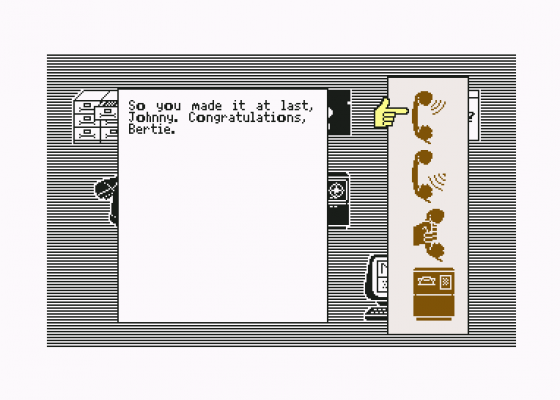
The game is a three part adventure game, the first two parts being icon-menu driven with part three being text input with some arcade-type sequences. In part one, you have to uncover a traitor within your ranks. This leads to part two where you have to discover exactly where the bomb is hidden and so to the final part and the actual defusion of the bomb. The three parts must be played in order, as successful completion of parts one and two yields a password allowing access to the next instalment.
Whilst you are settling into your new job as head of C1(A), responsible for security of Government buildings, a diamond robbery is taking place. The burglar discovers that he has got away with more than he bargained for and amongst his haul are some top secret Nato documents. Being a good patriot, he sends them anonymously to the Ministry of Defence and this is where the game starts.
Most of part one consists of information gathering from within your office and the icons on the screen depict varying functions that you can access. The icons are selected by moving a pointing finger round the screen and pressing the return key. Most of the icons, once selected, lead to a window full of further options. For example, selecting the picture of the telephone, gives you four choices: make an outgoing call (you are prompted for the number), listen to an incoming call, put the telephone on hold (so that you don't lose a call if you are doing something else!) and return to the main screen.

The icons are large, very well drawn and mostly self-explanatory. The telephone has already been described. The filing cabinet is used for storing memos and reports that you have accessed. The video camera allows you to put a surveillance team (watchers in the jargon) on to a suspect. The cassette lets you save different positions whilst the graph gives you details of your current prestige and how much of the game you have solved.
You have only forty days to solve part one of the game and the calendar charts your progress. Each "day" takes two minutes of computer time but once you have solved the early parts of the adventure, you can use the calendar icon to advance the date more rapidly.
The three VDUs across the bottom of the screen are your main sources of information. Normally blank symbols appear on the screen when there is something for you to read. From right to left, these are memos, reports and sitreps (reports from your watchers). Accessing one of these terminals gives you options to read, file or throw away the report. As the game progresses, more and more pieces of paper land on your deck, all of which need to be acted upon in one way or another. It's nice to know that even occupations as supposedly glamorous as spying have their problems with bumf.

So to the game itself. As mentioned earlier, your main task is to find out who has been leaking the Nato documents. But your job is concerned with all aspects of security in Government buildings and other people will want you to sort out their problems as well. Some of these other jobs will give you additional clues whilst others are merely designed to waste your time.
Having read the messages congratulating you on your new appointment, it is time to get down to some serious work. You soon discover that a young civil servant called Abbs is reportedly seeing a foreign national so you decide to put some watchers on her and see what happens. It is worth looking up the file called "telephone" at ths stage as it gives you some important numbers of use later in the game. The most frequently used of these numbers is the one for Blenheim - one of the other MI5 offices. By phoning them, you can get their files transferred to your office - providing of course that you know the name of the file that you want.
Another thing you will have to find out pretty quickly is exactly who had access to the leaked documents in order that you can check up on them and eliminate as many suspects as you can, as soon as possible.

No spy story is complete without its secret codes, and The Fourth Protocol is no exception. Memos come through at regular intervals telling you what the latest password is. You need to know this before you can access any of the files at Blenheim. Being security items, the passwords are not written down as such, but given to you in code. These have to be decoded using the one time pads which are included in the packaging of the game as a playing aid. These pads consists of an array of letters which are used to turn numbers into sequences and are in standard use amongst intelligence services throughout the world by virtue of being almost unbreakable.
Not all your time is spent in the office. A request comes through for you to install a security system at Building 17. When you get there, you are presented with a blueprint of the building and have to decide where to put security locks. If you do not get it correct first time, you get summoned again and again until you do. Getting annoyed with this, I put locks on every single door in the building. This resulted in a rather terse memo stating that they didn't now about what happened in London, but where they were, toilet rolls were not considered a security item and the union were threatening to go on strike if the locks weren't taken off the toilets pretty quickly!
As you complete different actions, so your prestige varies for better or for worse. The lower it gets, the fewer watches you will have at your disposal and so subsequent tasks become that much more difficult. The sort of thing that would affect your prestige would be the potential defection of a foreign diplomat. If you get him quickly enough, your prestige goes up as he tells MI6 everything he knows. If you don't get him in time, he defects to the Russians and down goes your prestige.
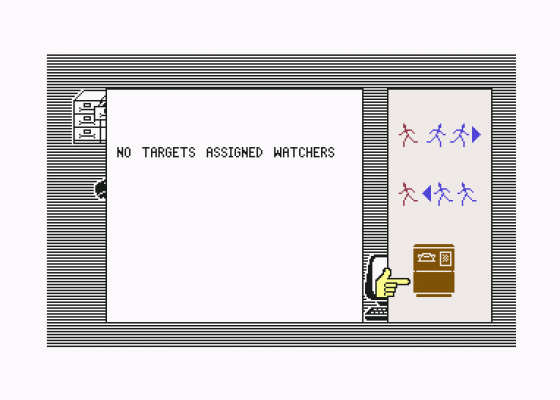
There are about fifteen different plots going on throughout the course of part one although you will not be aware of them all. Some are vital, some give subsidiary information and others are total red herrings. The way the plots fit together is cleverly done and there is a real feel of being these, especially with the variations in the memos and reports that you get. Unlike other adventures, where you have to go and look for things, here things come to you. Of course, you then have to act on them, but there is always something going on. You will have the opportunity for making voice print analysis, using the remarkable talents of Blodwyn with her incredible memory for faces and liaising with other security services, both your own and foreign, in your search for the traitor.
When you think you know who has been giving our secrets away, you have to convince the Paragon committee which has been set up to investigate the leaks. This involves answering a series of questions on who did it, how he was recruited, by who and what evidence there is. If you get everything correct (and be warned, it's not that easy) you get a password which allows entry to part two. If you get it wrong, the game continues but with an enormous dent in your prestige. If you do not successfully solve part one, the game ends automatically after the forty days have elapsed.
Your objective in part two is to discover the location of the bomb. Again, it is an icon-driven adventure, but this time there is a lot of travelling to be done and there are about 175 locations to be explored. The utility and assessment icons are the same as in part one, but several new ones are introduced. Communicate allows you to use the phone or talk to someone and wait is used to advance time. Manipulate lets you take, drop or use an object while look leads to a choice of examining an object, reading something or taking an inventory of your stock. The final icon is the one that enables you to move around. This gives a comprehensive choice of actions ranging from getting in a tube or taxi to entering a lift or following someone.

To start with, you will need to visit various MI5 buildings in order to equip yourself with ID, money etc. You will also meet a Q-type figure (to pinch a character from James Bond) who may be able to help equip you.
As you move around the country, following a group of terrorists that you have had a tip off about, you will find your way impeded by rail strikes and the like. Plus, of course, the fact that you never have the right to pass a piece of equipment at the right time. You have to do all your own legwork in this part, no teams of watchers to help you out here. As in part one, successful completion of part two gives you a password for part three. The task must be completed within a certain number of moves although this is fairly lenient and so you don't have to follow an exact course.
All that remains now, is the small matter of defusing the bomb and it is in this part that the Spectrum and C64 versions differ considerably. The original specification of the game called for an arcade game in part three, but the writers - the Electronic Pencil Company - felt that this would destroy the feel of the game. The Spectrum version was so far advanced though it was decided to leave the arcade element in. Having found the location of the bomb in part two, you have to plan an SAS raid on the building. You must arm the six soldiers at your disposal before sending them into the building for a shootout with the KGB thugs. This is depicted as a "Berzerk-style" game with both sets of agents dodging round the furniture in an attempt to kill each other. Only when all the Russians are dead are you allowed into the room with the bomb.
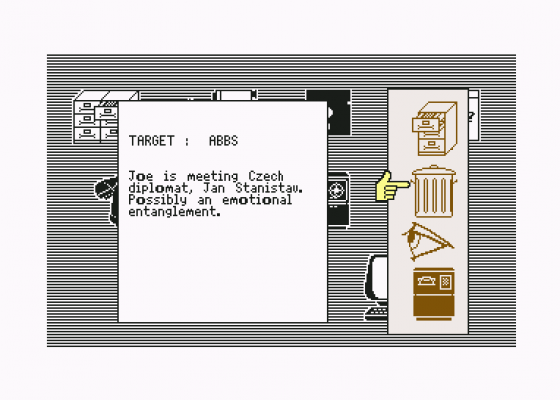
The C64 version puts you straight into the room with the bomb, with the battle raging around you. This is a graphical adventure with text input. The KGB can still find you if you don't take suficient precautions but will not however shoot you for fear of detonating the bomb. They will try to overpower you though and will succeed if too many of them get near you.
The bomb is hidden inside a cabinet and your first problem is to find a way into it. This requires a combination number that you should have come across earlier in the game. Any other attempt at opening the cabinet, such as a hefty kick will result in the bomb detonating prematurely, and you going up in a mushroom cloud. Once the cabinet is open, the bomb is revealed, together with a series of flashing lights. These have to be pressed in the correct sequence. Again, you should have found this out from earlier in the game, but it is not too difficult to work out. All the time that this is happening, a clock is ticking away, and the pressure of trying to do everything before it reaches zero starts to mount. If you get the correct sequence, you are presented with three wires to be cut. You cut one and still the clock keeps ticking...
The Fourth Protocol is the first serious attempt at a game based on a spy story that I have seen and it works very well indeed. The use of icons makes the game a lot friendlier to use than text input and the storyline flows well and maintains a high level of excitement. This is due in no small way to Frederick Forsyth. I read The Fourth Protocol before playing the game and was more than a little worried that the game would not do it justice, but my fears proved groundless. The weakest part of the game is the third part and there is a feeling that it has only been put in to let the player see the plot through to the end. The part that will get everyone talking though and discussing it with their friends is part one, which is highly original and extremely well implemented.
The Fourth Protocol is published by Hutchinson for the Spectrum and Commodore 64 and costs £12.95.

